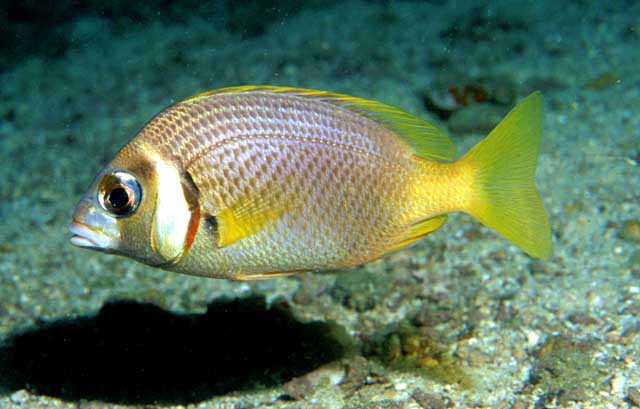| Nemipteridae (Threadfin breams, Whiptail breams) |
| 17.31 cm SL (male/unsexed) |
|
reef-associated; marine; depth range 2 - 25 m |
| Indo-West Pacific: northern Indian Ocean (except the Red Sea, Arabian Gulf, east African coast, islands), from Pakistan, western India, Sri Lanka; Bay of Bengal and Andaman to western Indonesia and Borneo (East Malaysia and Brunei). |
|
Dorsal spines (total): 10-10; Dorsal soft rays (total): 9-9; Anal spines: 3-3; Anal soft rays: 7-7; Vertebrae: 22-22. This species is distinguished by the following set of characters: scaly temporal region with scales on top of head reaching forward to just in front of the anterior nostrils; naked suborbital; the lower margin of the eye is tangent to or just above a line from snout tip to upper pectoral-fin base; exposed bony ridge below the eye with an antrorse and retrorse spine; scales on preopercle are extending to posterior margin, scales behind suborbital 5-6 rows and behind eye 3-4 rows; the lower limb of preopercle usually has a single row of embedded scales; scales on opercle 4-7 rows; most body scales (except for caudal peduncle) have a black spot; caudal peduncle white; usually a white band is present beneath lateral line, from origin of lateral line to below posterior part of dorsal fin; from nape onto operculum is a broad white bar, and suborbital with distinctive white patch - all these not present in juveniles and smaller subadults; upper limb of opercular margin narrowly brown, the lower limb narrowly reddish-orange; upper base of pectoral fin with a small dark spot; pelvic and anal fins are crimson or orange-red (Ref. 120656). |
| Benthic in inshore turbid or weedy waters, usually on sand or mud or rubble bottoms close to reefs, in depths to about 30 m (Ref. 92980), as well as offshore areas (Ref. 9785). Seen solitary, but may school deep (Ref. 48635). |
|
Least Concern (LC); Date assessed: 12 April 2023 Ref. (130435)
|
| harmless |
Source and more info: www.fishbase.org. For personal, classroom, and other internal use only. Not for publication.
